Vue项目打包后动态配置解决方案
Vue项目打包后动态配置解决方案
前言
首先特别感谢群里小伙伴 @你钉钉响了 提供Vue项目打包后动态配置的解决方案~【趁机白嫖过来】
最近在用docker compose构建蘑菇博客的镜像,后端容器在启动的时候,因为是从nacos中读取配置的,因此别人拉取到镜像后,只需要修改nacos的配置即可动态的修改后端项目配置。
前端项目使用Vue开发,在制作前端镜像时,对Vue项目打包后生成dist静态文件,无法读取到系统配置。这也造成了我之前的局面:每次提交一个镜像后,如果别人拉取到镜像下来,需要进行 重新 修改配置,依赖安装,打包成镜像 等繁琐的操作。这种方式简直对小白不太友好,增加了部署时的成本【环境搭建劝退】,后面参考 猪齿鱼 项目的环境解决方案,来进行修改。
需要修改的文件
这里主要列举出需要修改的文件,下面可以对照着进行添加和修改
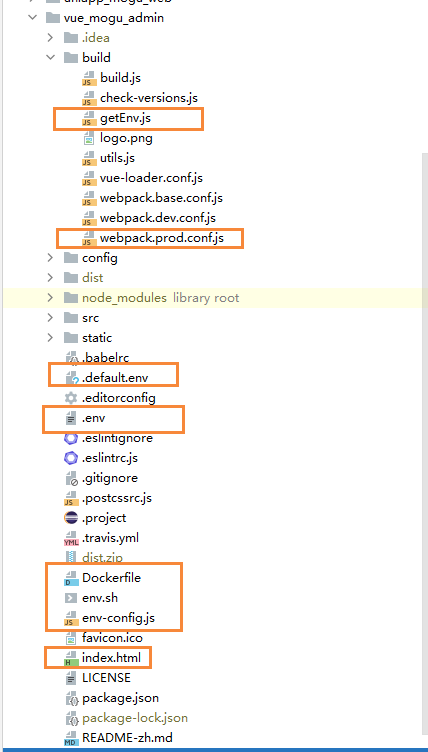
添加.env文件
首先我们在 vue_mogu_admin项目的目录下,添加 .env 文件,用来保存变量,内容如下
NODE_ENV=production
WEB_API=http://120.78.126.96:8603
FILE_API=http://120.78.126.96:8600/
RABBIT_MQ_ADMIN=http://120.78.126.96:15672
SENTINEL_ADMIN=http://120.78.126.96:8070/sentinel/
EUREKA_API=http://120.78.126.96:8761
Search_API=http://120.78.126.96:8605
ADMIN_API=http://120.78.126.96:8601
Zipkin_Admin=http://120.78.126.96:9411/zipkin/
DRUID_ADMIN=http://120.78.126.96:8601/druid/login.html
SPRING_BOOT_ADMIN=http://120.78.126.96:8606/wallboard
BLOG_WEB_URL=http://120.78.126.96:9527
ELASTIC_SEARCH=http://120.78.126.96:5601
PICTURE_API=http://120.78.126.96:8602
SOLR_API=http://120.78.126.96:8080/solr
这里的环境变量,其实就是原来的 prod.env.js 里面的
添加.defualt.env文件
我们在 vue_mogu_admin项目的目录下, 创建一个空的文件 .defualt.env ,用于以后添加默认配置
添加 env-config.js文件
然后我们继续在 vue_mogu_admin 项目的目录下,添加 env-config.js 文件,内容如下
window._env_ = {};
添加 getEnv.js文件
在vue_mogu_admin\build 目录下,添加 getEnv.js 文件,用于获取 .env 中的配置,解析为js字符串
const fs = require('fs');
const paths = require('path');
const appDirectory = fs.realpathSync(process.cwd());
const resolveApp = (relativePath) => paths.resolve(appDirectory, relativePath);
function parse(src, options) {
const debug = Boolean(options && options.debug);
const obj = {};
src.toString().split('\n').forEach((line, idx) => {
const keyValueArr = line.match(/^\s*([\w.-]+)\s*=\s*(.*)?\s*$/);
if (keyValueArr != null) {
const key = keyValueArr[1];
let value = keyValueArr[2] || '';
const len = value ? value.length : 0;
if (len > 0 && value.charAt(0) === '"' && value.charAt(len - 1) === '"') {
value = value.replace(/\\n/gm, '\n');
}
value = value.replace(/(^['"]|['"]$)/g, '').trim();
obj[key] = value;
} else if (debug) {
// eslint-disable-next-line no-console
console.log(`did not match key and value when parsing line ${idx + 1}: ${line}`);
}
});
return obj;
}
function config(filePath) {
const encoding = 'utf8';
const debug = false;
if (filePath) {
try {
const parsed = parse(fs.readFileSync(filePath, { encoding }), { debug });
return { parsed };
} catch (e) {
return { error: e };
}
}
throw new Error('.env path cannot be empty');
}
/**
* 获取.env中的配置,解析为js字符串
* @param {*} isDev
*/
function getEnv() {
const customConfig = config(resolveApp('.env'));
const combineEnv = customConfig.parsed;
return `window._env_ = ${JSON.stringify(combineEnv)};`;
}
module.exports = getEnv;
更改webpack.prod.conf.js文件
核心代码
接着我们在webpack.prod.conf.js 文件中修改我们的环境变量值,改成从 window._env_ 中获取,而不是从原来的prod.env.js 中获取 【这也说明.. 我们原来的 prod.env.js 已经用不上了~】
const fs = require('fs');
const paths = require('path');
const appDirectory = fs.realpathSync(process.cwd());
const resolveApp = (relativePath) => paths.resolve(appDirectory, relativePath);
function parse(src, options) {
const debug = Boolean(options && options.debug);
const obj = {};
src.toString().split('\n').forEach((line, idx) => {
const keyValueArr = line.match(/^\s*([\w.-]+)\s*=\s*(.*)?\s*$/);
if (keyValueArr != null) {
const key = keyValueArr[1];
let value = keyValueArr[2] || '';
const len = value ? value.length : 0;
if (len > 0 && value.charAt(0) === '"' && value.charAt(len - 1) === '"') {
value = value.replace(/\\n/gm, '\n');
}
value = value.replace(/(^['"]|['"]$)/g, '').trim();
obj[key] = value;
} else if (debug) {
// eslint-disable-next-line no-console
console.log(`did not match key and value when parsing line ${idx + 1}: ${line}`);
}
});
return obj;
}
function config(filePath) {
const encoding = 'utf8';
const debug = false;
if (filePath) {
try {
const parsed = parse(fs.readFileSync(filePath, { encoding }), { debug });
return { parsed };
} catch (e) {
return { error: e };
}
}
throw new Error('.env path cannot be empty');
}
/**
* 获取.env中的配置,解析为js字符串
* @param {*} isDev
*/
function getEnv() {
const customConfig = config(resolveApp('.env'));
const combineEnv = customConfig.parsed;
return `window._env_ = ${JSON.stringify(combineEnv)};`;
}
module.exports = getEnv;
4、更改webpack.prod.conf.js
核心代码
const getEnv = require('./getEnv')
new webpack.DefinePlugin({
'process.env': `window._env_` //构建时定义process.env值为window._env_的值
}),
new HtmlWebpackPlugin({
filename: config.build.index,
template: 'index.html',
inject: true,
favicon: resolve('favicon.ico'),
title: '蘑菇云后台管理系统',
env: getEnv(), //插件生成html模本读取.env文件为env
minify: {
removeComments: true,
collapseWhitespace: true,
removeAttributeQuotes: true
// more options:
// https://github.com/kangax/html-minifier#options-quick-reference
}
// default sort mode uses toposort which cannot handle cyclic deps
// in certain cases, and in webpack 4, chunk order in HTML doesn't
// matter anyway
}),
new CopyWebpackPlugin([
{
from: path.resolve(__dirname, '../static'),
to: config.build.assetsSubDirectory,
ignore: ['.*']
},
//拷贝新增的四个文件到dist中
{
from: path.resolve(__dirname,'../.env'),
to: './'
},
{
from: path.resolve(__dirname, '../env.sh'),
to: './'
},
{
from: path.resolve(__dirname, '../.default.env'),
to: './'
},
{
from: path.resolve(__dirname, '../env-config.js'),
to: './'
},
])
完整代码
完整的代码如下所示
'use strict'
const path = require('path')
const utils = require('./utils')
const webpack = require('webpack')
const config = require('../config')
const merge = require('webpack-merge')
const baseWebpackConfig = require('./webpack.base.conf')
const CopyWebpackPlugin = require('copy-webpack-plugin')
const HtmlWebpackPlugin = require('html-webpack-plugin')
const ScriptExtHtmlWebpackPlugin = require('script-ext-html-webpack-plugin')
const MiniCssExtractPlugin = require('mini-css-extract-plugin')
const OptimizeCSSAssetsPlugin = require('optimize-css-assets-webpack-plugin')
const UglifyJsPlugin = require('uglifyjs-webpack-plugin')
const getEnv = require('./getEnv')
function resolve(dir) {
return path.join(__dirname, '..', dir)
}
// For NamedChunksPlugin
const seen = new Set()
const nameLength = 4
const webpackConfig = merge(baseWebpackConfig, {
mode: 'production',
module: {
rules: utils.styleLoaders({
sourceMap: config.build.productionSourceMap,
extract: true,
usePostCSS: true
})
},
devtool: config.build.productionSourceMap ? config.build.devtool : false,
output: {
path: config.build.assetsRoot,
filename: utils.assetsPath('js/[name].[chunkhash:8].js'),
chunkFilename: utils.assetsPath('js/[name].[chunkhash:8].js')
},
plugins: [
// http://vuejs.github.io/vue-loader/en/workflow/production.html
new webpack.DefinePlugin({
'process.env': `window._env_`
}),
// extract css into its own file
new MiniCssExtractPlugin({
filename: utils.assetsPath('css/[name].[contenthash:8].css'),
chunkFilename: utils.assetsPath('css/[name].[contenthash:8].css')
}),
// generate dist index.html with correct asset hash for caching.
// you can customize output by editing /index.html
// see https://github.com/ampedandwired/html-webpack-plugin
new HtmlWebpackPlugin({
filename: config.build.index,
template: 'index.html',
inject: true,
favicon: resolve('favicon.ico'),
title: '蘑菇云后台管理系统',
env: getEnv(),
minify: {
removeComments: true,
collapseWhitespace: true,
removeAttributeQuotes: true
// more options:
// https://github.com/kangax/html-minifier#options-quick-reference
}
// default sort mode uses toposort which cannot handle cyclic deps
// in certain cases, and in webpack 4, chunk order in HTML doesn't
// matter anyway
}),
new ScriptExtHtmlWebpackPlugin({
//`runtime` must same as runtimeChunk name. default is `runtime`
inline: /runtime\..*\.js$/
}),
// keep chunk.id stable when chunk has no name
new webpack.NamedChunksPlugin(chunk => {
if (chunk.name) {
return chunk.name
}
const modules = Array.from(chunk.modulesIterable)
if (modules.length > 1) {
const hash = require('hash-sum')
const joinedHash = hash(modules.map(m => m.id).join('_'))
let len = nameLength
while (seen.has(joinedHash.substr(0, len))) len++
seen.add(joinedHash.substr(0, len))
return `chunk-${joinedHash.substr(0, len)}`
} else {
return modules[0].id
}
}),
// keep module.id stable when vender modules does not change
new webpack.HashedModuleIdsPlugin(),
// copy custom static assets
new CopyWebpackPlugin([
{
from: path.resolve(__dirname, '../static'),
to: config.build.assetsSubDirectory,
ignore: ['.*']
},
{
from: path.resolve(__dirname,'../.env'),
to: './'
},
{
from: path.resolve(__dirname, '../env.sh'),
to: './'
},
{
from: path.resolve(__dirname, '../.default.env'),
to: './'
},
{
from: path.resolve(__dirname, '../env-config.js'),
to: './'
},
])
],
optimization: {
splitChunks: {
chunks: 'all',
cacheGroups: {
libs: {
name: 'chunk-libs',
test: /[\\/]node_modules[\\/]/,
priority: 10,
chunks: 'initial' // 只打包初始时依赖的第三方
},
elementUI: {
name: 'chunk-elementUI', // 单独将 elementUI 拆包
priority: 20, // 权重要大于 libs 和 app 不然会被打包进 libs 或者 app
test: /[\\/]node_modules[\\/]element-ui[\\/]/
}
}
},
runtimeChunk: 'single',
minimizer: [
new UglifyJsPlugin({
uglifyOptions: {
mangle: {
safari10: true
}
},
sourceMap: config.build.productionSourceMap,
cache: true,
parallel: true
}),
// Compress extracted CSS. We are using this plugin so that possible
// duplicated CSS from different components can be deduped.
new OptimizeCSSAssetsPlugin()
]
}
})
if (config.build.productionGzip) {
const CompressionWebpackPlugin = require('compression-webpack-plugin')
webpackConfig.plugins.push(
new CompressionWebpackPlugin({
asset: '[path].gz[query]',
algorithm: 'gzip',
test: new RegExp(
'\\.(' + config.build.productionGzipExtensions.join('|') + ')$'
),
threshold: 10240,
minRatio: 0.8
})
)
}
if (config.build.generateAnalyzerReport || config.build.bundleAnalyzerReport) {
const BundleAnalyzerPlugin = require('webpack-bundle-analyzer')
.BundleAnalyzerPlugin
if (config.build.bundleAnalyzerReport) {
webpackConfig.plugins.push(
new BundleAnalyzerPlugin({
analyzerPort: 8080,
generateStatsFile: false
})
)
}
if (config.build.generateAnalyzerReport) {
webpackConfig.plugins.push(
new BundleAnalyzerPlugin({
analyzerMode: 'static',
reportFilename: 'bundle-report.html',
openAnalyzer: false
})
)
}
}
module.exports = webpackConfig
修改index.html
然后我们修改 vue_mogu_admin\index.html 文件,我们需要在index.html 把我们的环境变量放入进去
<script id=env><%= htmlWebpackPlugin.options.env %></script>
我是放在 <head></head>中
<head>
<meta charset="utf-8">
<meta name="viewport" content="width=device-width,initial-scale=1.0">
<title>蘑菇云后台管理系统</title>
<script id='env'><%= htmlWebpackPlugin.options.env %></script>
</head>
添加env.sh
下面我们需要在 vue_mogu_admin 目录下添加 env.sh 文件,用于容器启动时,替换环境变量
#!/bin/bash
set -x
set -e
# Recreate config file
absolute_path=$(cd `dirname $0`; pwd)
env_config=${absolute_path}/env-config.js
rm -rf ${env_config}
touch ${env_config}
# Add assignment
echo "window._env_ = {" >> ${env_config}
# Read each line in .env file
# Each line represents key=value pairs
sed -i '/^[[:space:]]*$/d' ${absolute_path}/.env
while read -r line || [[ -n "$line" ]];
do
# Split env variables by character `=`
if printf '%s\n' "$line" | grep -q -e '='; then
varname=$(printf '%s\n' "$line" | sed -e 's/=.*//')
varvalue=$(printf '%s\n' "$line" | sed -e 's/^[^=]*=//')
fi
# Read value of current variable if exists as Environment variable
value=$(printf '%s\n' "${!varname}")
# Otherwise use value from .env file
[[ -z $value ]] && value=${varvalue}
# Append configuration property to JS file
echo " $varname: \"$value\"," >> ${env_config}
done < ${absolute_path}/.env
sed -i '/^[[:space:]]*$/d' ${absolute_path}/.default.env
while read -r line || [[ -n "$line" ]];
do
# Split env variables by character `=`
if printf '%s\n' "$line" | grep -q -e '='; then
varname=$(printf '%s\n' "$line" | sed -e 's/=.*//')
varvalue=$(printf '%s\n' "$line" | sed -e 's/^[^=]*=//')
fi
# Read value of current variable if exists as Environment variable
value=$(printf '%s\n' "${!varname}")
# Otherwise use value from .env file
[[ -z $value ]] && value=${varvalue}
# Append configuration property to JS file
echo " $varname: \"$value\"," >> ${env_config}
done < ${absolute_path}/.default.env
echo "}" >> ${env_config}
sed -e "s/\//\\\/g" ${env_config}
STR=`echo $(cat ${env_config}) | sed 's#\/#\\\/#g'`
mv ${absolute_path}/index.html ${absolute_path}/index.html.bak
#sed -e "s/window\.\_env\_.*\}\;/${STR}/g" ${absolute_path}/index.html.bak > ${absolute_path}/index.html
sed -e "s#<script id=env>window._env_.*\};</script>#<script id=env>${STR};</script>#g" ${absolute_path}/index.html.bak > ${absolute_path}/index.html
cat ${env_config}
exec "$@"
编写Dockerfile
下面我们就可以编写Dockerfile文件进行Docker镜像构建相关操作
FROM registry.cn-shenzhen.aliyuncs.com/mogu-zh/nginx:latest
ADD ./dist/ /usr/share/nginx/html
RUN sed -i 's/\r$//' /usr/share/nginx/html/env.sh
RUN chmod +x /usr/share/nginx/html/env.sh
ENTRYPOINT ["/usr/share/nginx/html/env.sh"]
CMD ["nginx", "-g", "daemon off;"]
上述的Dockerfile文件,主要就是以nginx作为基础镜像,然后将我们的 dist文件夹放到 nginx目录下,然后执行脚本进行替换环境变量
打包镜像
完成上述的操作后,我们就可以在服务器上进行vue_mogu_admin的镜像构建了,然后提交到DockerHub中
# 安装依赖
npm install
# 打包
npm run build
# 构建镜像
docker build -t moxi/vue_mogu_admin .
# 提交镜像
docker push moxi/vue_mogu_web
最后在DockerHub就能看到我们刚刚构建的镜像

测试
默认配置
在构建好镜像后,我们就可以在服务器拉取我们的镜像进行测试,首先测试使用默认的配置
docker run --name vue_mogu_web -d -it -p 9527:80 moxi/vue_mogu_web
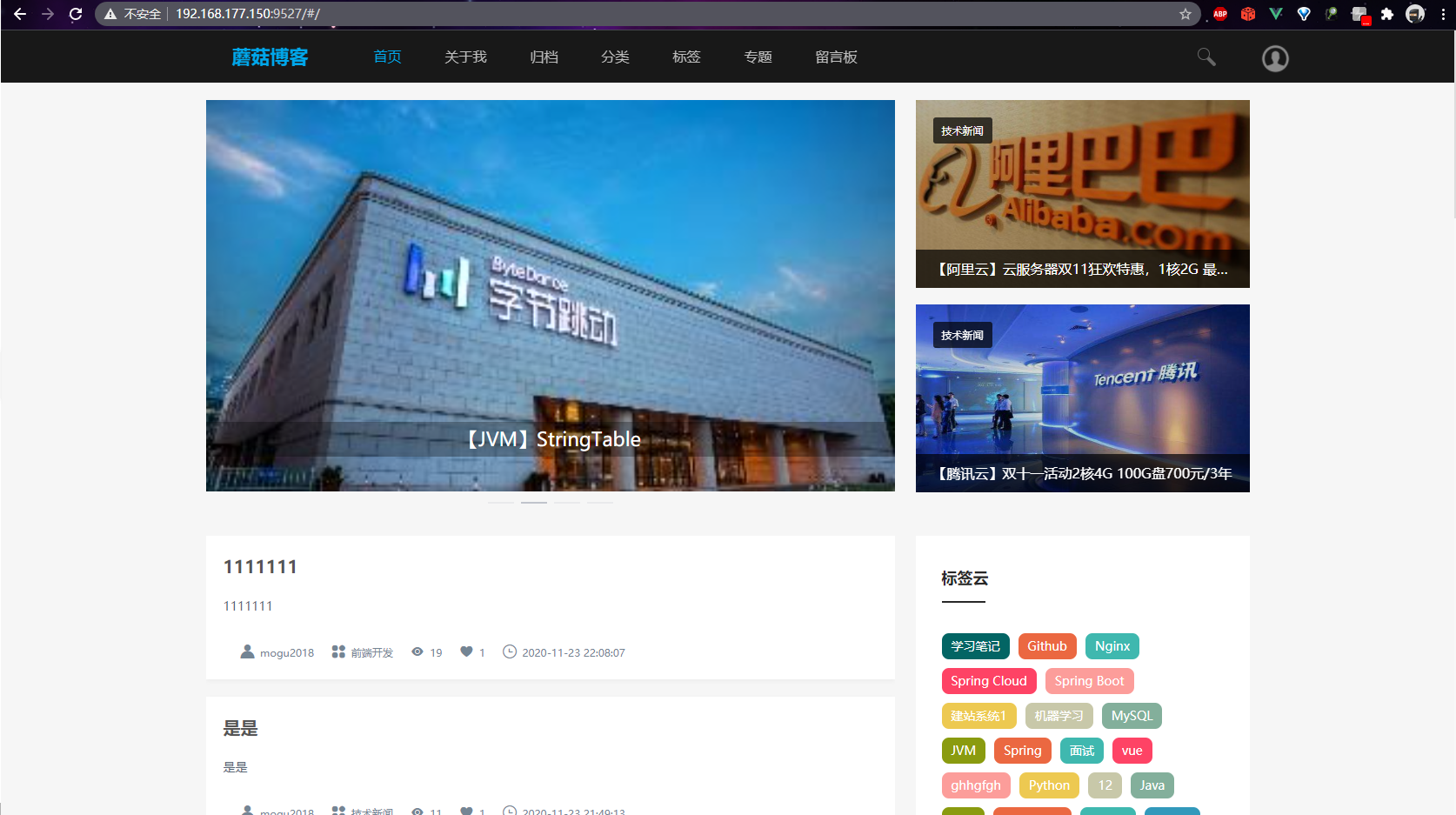
能看到下面的请求的IP如下所示
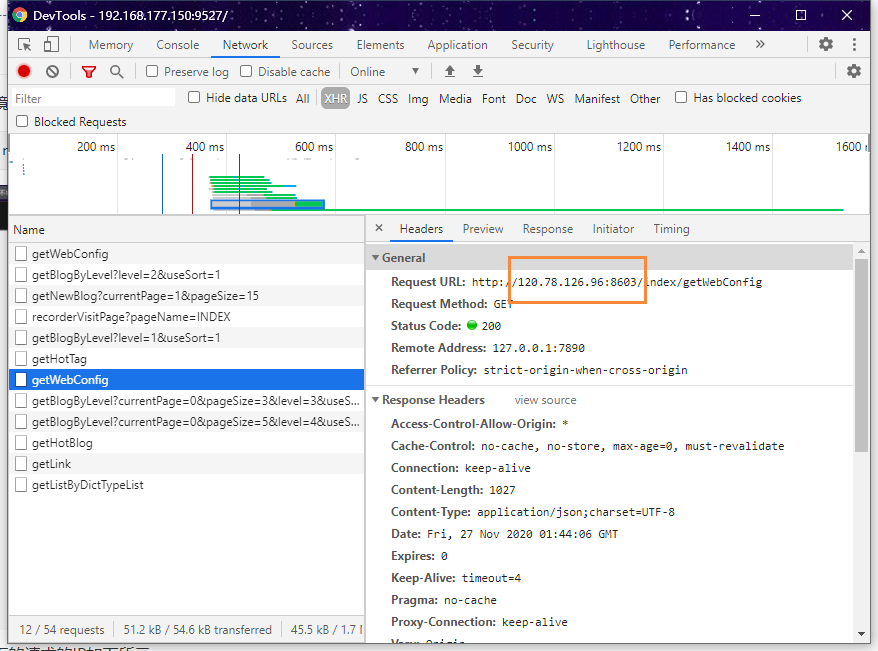
动态配置
下面我们在启动的时候,携带我们的变量
docker run --name vue_mogu_web -d -it \
-e VUE_MOGU_WEB=http://101.132.194.128:9527 \
-e PICTURE_API=http://101.132.194.128:8602 \
-e PICTURE_API=http://101.132.194.128:8602 \
-e WEB_API=http://101.132.194.128:8603 \
-e ELASTICSEARCH=http://101.132.194.128:8605 \
-p 9527:80 moxi/vue_mogu_web
执行完成后,我们再次打开页面,发现已经变成了蘑菇博客的线上环境了~
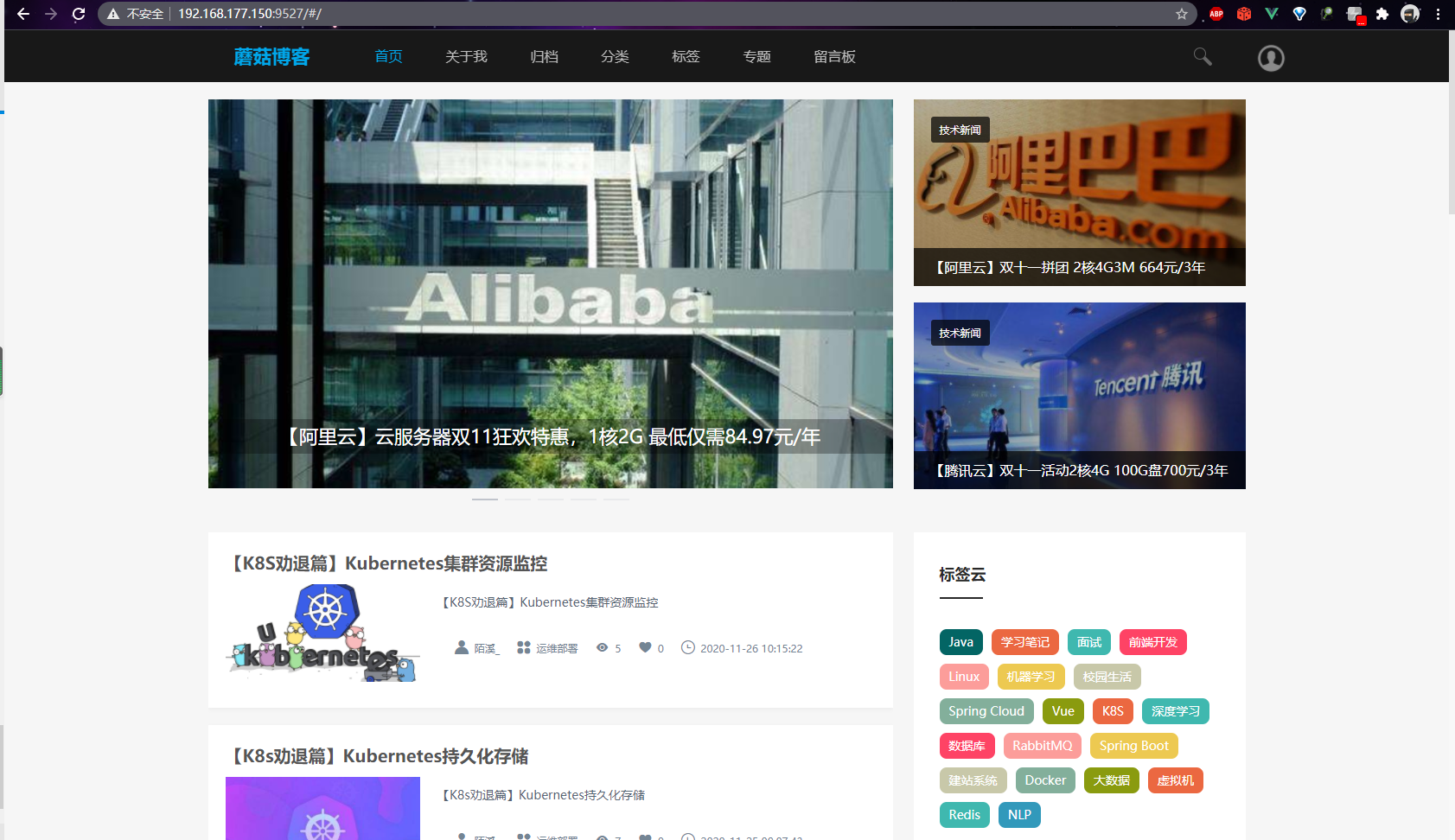
打开F12,查看请求端口,发现ip地址已经成功修改了
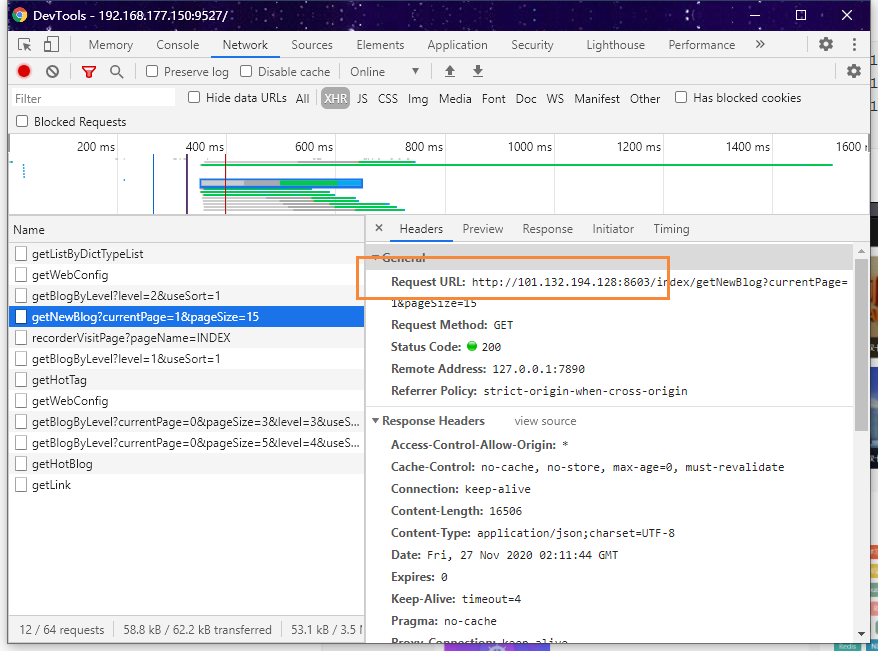
到此为止,动态配置解决方案已经完成 ~
你可能感兴趣的文章
热门推荐
-
2、 - 优质文章
-
3、 gate.io
-
8、 golang
-
9、 openharmony
-
10、 Vue中input框自动聚焦